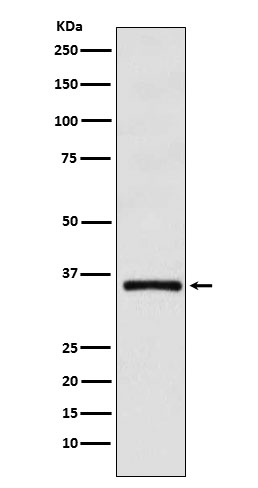
| WB | 1/1000-1/2000 | Human,Mouse,Rat |
| IF | 1/20-1/50 | Human,Mouse,Rat |
| IHC | 咨询技术 | Human,Mouse,Rat |
| ICC | 技术咨询 | Human,Mouse,Rat |
| FCM | 咨询技术 | Human,Mouse,Rat |
| Elisa | 咨询技术 | Human,Mouse,Rat |
| Aliases | CT154; dmrt1; DMT1;;DMRT1 |
| WB Predicted band size | Calculated MW: 39 kDa ; Observed MW: 34 kDa |
| Host/Isotype | Rabbit IgG |
| Antibody Type | Primary antibody |
| Storage | Store at 4°C short term. Aliquot and store at -20°C long term. Avoid freeze/thaw cycles. |
| Species Reactivity | Human |
| Immunogen | A synthesized peptide derived from human DMRT1 |
| Formulation | Purified antibody in PBS with 0.05% sodium azide,0.05% BSA and 50% glycerol. |
+ +
以下是3篇与DMRT1抗体相关的文献及其摘要概括:
---
1. **文献名称**:*DMRT1 is required for mouse spermatogonial stem cell maintenance*
**作者**:Matson CK, et al.
**摘要**:该研究利用特异性DMRT1抗体通过免疫荧光和流式细胞术,证明DMRT1蛋白在小鼠精原干细胞中的关键作用,敲除后导致干细胞自我更新能力丧失。
---
2. **文献名称**:*Conserved role of DMRT1 in vertebrates: Insights from chicken gonad development*
**作者**:Smith CA, et al.
**摘要**:通过Western blot和免疫组化,研究发现鸡胚胎性腺中DMRT1的表达模式与哺乳动物类似,抗体检测显示其在睾丸支持细胞中高表达,支持其进化保守的性别决定功能。
---
3. **文献名称**:*DMRT1 suppresses tumor metastasis in human colorectal cancer*
**作者**:Li Y, et al.
**摘要**:该文献利用DMRT1抗体进行免疫组化分析,发现结直肠癌组织中DMRT1低表达与转移相关,体外实验表明过表达DMRT1可抑制癌细胞侵袭,提示其抑癌潜力。
---
这些研究均依赖DMRT1抗体进行蛋白定位或定量分析,涵盖发育生物学和疾病机制领域。如需具体期刊或年份信息可进一步补充。
DMRT1 (Doublesex and Mab-3 Related Transcription factor 1) is a conserved zinc finger-like transcription factor critical for vertebrate sexual development and gametogenesis. It plays a pivotal role in testis determination, differentiation of Sertoli cells, and maintenance of germ cell identity across species. The DMRT1 protein contains a DNA-binding DM domain, enabling regulation of target genes involved in sex determination pathways. In mammals, DMRT1 is predominantly expressed in fetal gonads and adult testes, with mutations or deletions linked to disorders of sexual development, including gonadal dysgenesis and sex reversal.
DMRT1 antibodies are essential tools for studying its expression patterns, molecular interactions, and functional mechanisms. These antibodies are widely used in techniques like Western blotting, immunohistochemistry, and chromatin immunoprecipitation (ChIP) to investigate DMRT1's spatiotemporal localization, protein levels, and regulatory networks. Commercially available antibodies are typically raised against specific epitopes, such as the N-terminal or DM domain, with validation in model organisms (e.g., mice, chickens, fish) reflecting DMRT1's evolutionary conservation. Their applications span developmental biology, reproductive disorders, and cancer research, particularly in tumors with disrupted sexual differentiation pathways. Quality validation (e.g., knockout controls) is crucial due to potential cross-reactivity with other DM domain proteins.
×